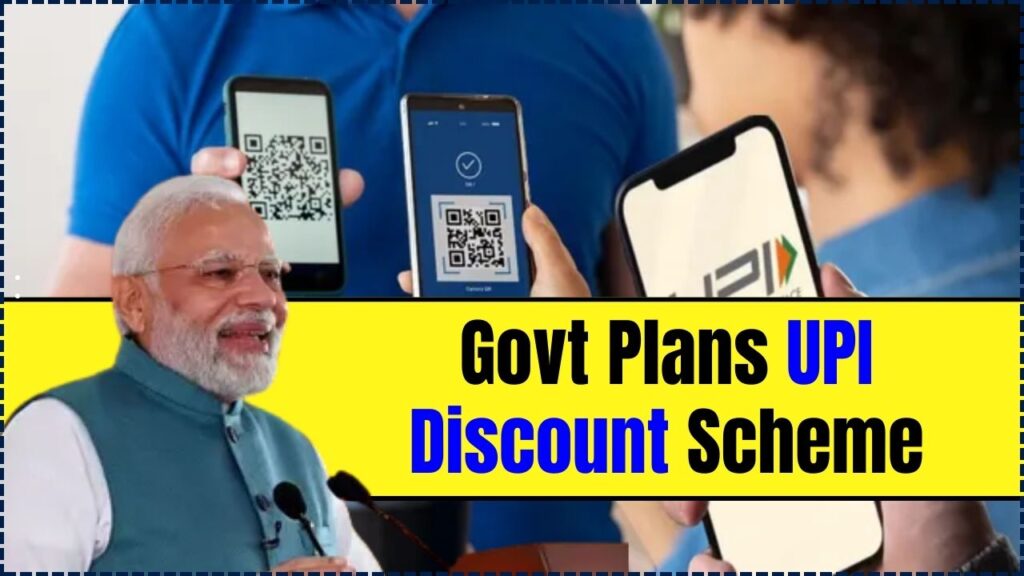Govt Plans UPI Discount Scheme: The Govt plans UPI discount scheme to make digital payments more attractive to everyday consumers, marking a significant step toward a cashless economy in India. If approved and implemented, this scheme could allow users to enjoy instant discounts on UPI transactions, saving money each time they shop using platforms like Google Pay, PhonePe, Paytm, and BHIM. This initiative is expected to be part of a broader policy shift aimed at improving financial inclusion and pushing India further into the digital age.

At a time when digital transactions are growing exponentially, the government aims to push the needle further by offering a 2% discount on eligible UPI payments. That means a transaction worth ₹100 might only cost you ₹98, providing an immediate, hassle-free benefit. This incentive may seem small in a single instance, but over hundreds of transactions in a year, it could amount to substantial savings. Here’s what you need to know and how it could impact both consumers and small merchants.
Govt Plans UPI Discount Scheme
| Topic | Details |
|---|---|
| Policy | Proposed UPI Discount Scheme |
| Discount Rate | 2% instant discount on UPI payments |
| Eligible Platforms | UPI apps like BHIM, Google Pay, PhonePe, Paytm |
| Target Audience | Everyday consumers and small merchants |
| Supportive Scheme | ₹1,500 crore incentive for BHIM-UPI transactions up to ₹2000 |
| Consulting Authorities | NPCI, Ministry of Consumer Affairs, e-commerce platforms, banks |
| Implementation Timeline | Under discussion, possible rollout in late 2025 or early 2026 |
| Official Resource | NPCI Website |
The Govt’s plan for a UPI discount scheme is a forward-thinking move to accelerate India’s transition to a digital economy. By offering instant savings to consumers and incentives to merchants, the initiative aims to boost financial inclusion, transparency, and ease of doing business. It reflects India’s digital ambitions and showcases how policy and technology can combine to create meaningful change.
While details are still unfolding, the potential impact is enormous. This is a move that could redefine how India transacts, saves, and shops. Stay informed and get ready to save on your everyday payments, while becoming a more empowered digital citizen.
What Is the UPI Discount Scheme?
The proposed Unified Payments Interface (UPI) discount scheme is a government-backed initiative aimed at encouraging wider adoption of digital payments in India. Under this scheme, consumers will get an immediate discount (2%) on payments made via UPI when buying goods or services. The aim is to promote financial efficiency and reduce the country’s dependence on cash transactions.
For instance, if you purchase groceries worth ₹1000 using a UPI app, you might only pay ₹980. This discount would be automatically applied at the point of sale, whether you’re shopping at a local kirana store or through an online platform. For retailers, this also opens the door to increased customer loyalty and faster transaction processing.
The initiative also complements ongoing efforts by the National Payments Corporation of India (NPCI) and the Reserve Bank of India (RBI) to strengthen India’s digital payment infrastructure.
Why Govt Plans UPI Discount Scheme?
The UPI discount scheme isn’t just about small savings. It’s a strategic push to make India less dependent on cash and move toward a fully digital economy. Digital transactions are safer, faster, and easier to trace, offering broad benefits for consumers, merchants, and policymakers alike.
1. Encourage Digital Payments
Despite UPI’s growing popularity, a significant portion of India still relies on cash. Instant discounts offer a tangible incentive for everyday consumers to choose digital first. This not only helps consumers but also reduces the cost of printing and circulating physical currency.
2. Reduce Costs for Merchants
Unlike credit cards, UPI transactions generally have zero or minimal Merchant Discount Rates (MDR). Encouraging UPI over cards reduces costs for small merchants. Since many small vendors work on narrow profit margins, even a small fee saved is valuable.
3. Boost Transparency and Tax Compliance
Digital transactions are easily traceable, helping curb tax evasion and bringing more small businesses into the formal economy. Increased transparency enhances access to formal credit systems and government support programs.
4. Modernize the Economy
This scheme contributes to India’s broader goal of becoming a digitally empowered society. It aligns with initiatives like Digital India, Jan Dhan Yojana, and Aadhaar-enabled payment systems.
How Will It Work?
While the scheme is still in the planning phase, here is an overview of how it might function:
Step-by-Step Breakdown:
- Eligible Transaction: A consumer initiates a payment using a UPI app.
- Verification: The transaction is identified as eligible for a discount (e.g., specific merchant category, minimum purchase).
- Instant Discount: A 2% discount is automatically deducted at the payment gateway.
- Final Payment: The reduced amount is charged to the consumer’s bank account.
- Merchant Reimbursement: The government or partnering banks may reimburse merchants for the discount difference.
- Auditing and Compliance: Periodic checks may be introduced to ensure there is no misuse or duplication of discount claims.
This structure ensures both instant gratification for consumers and revenue neutrality for merchants. The proposed system will likely use Application Programming Interfaces (APIs) to automate these processes across payment gateways and banks.
Complementary Incentives for Merchants
The government has already approved a ₹1,500 crore scheme to encourage small merchants to accept UPI payments, particularly those up to ₹2000. This program offers a 0.15% incentive per transaction to merchants, helping offset any technical or operational costs. These incentives will be distributed directly into merchant bank accounts.
Benefits for Merchants:
- No MDR fees, resulting in cost savings
- Cashless transaction benefits: easier bookkeeping, less cash handling, reduced theft risk
- Access to financial products: loan approvals based on digital transaction records
- Direct government incentives: encouraging participation and ecosystem expansion
- Increased customer trust and loyalty: digital receipts, real-time confirmations
Impact on Consumers: Real-World Examples
Let’s see how this might look in daily life:
- Example 1: You buy fruits from a local vendor for ₹500. Using UPI, you pay only ₹490. Repeat this 10 times, and you’ve saved ₹100.
- Example 2: You purchase books online worth ₹2000. You pay ₹1960 instead. Over a year, your online spending could save you ₹2,000 or more.
- Example 3: Monthly grocery bill of ₹5,000 drops to ₹4,900 if paid through UPI. That’s a yearly savings of ₹1200 for a single household.
Even middle-income families could save thousands of rupees per year, making this a financially meaningful program. For students, seniors, and low-income households, the savings may be even more impactful.
Challenges and Considerations
While the idea has promise, it’s not without challenges:
1. Implementation Logistics
Will discounts be universal or limited to select merchants and platforms? The backend system must be robust enough to support real-time discounts, especially during peak hours and festival seasons.
2. Fraud and Misuse Risks
With any financial incentive scheme, there is a risk of gaming the system. Safeguards will need to be established, such as transaction caps, unique user verification, and audit trails.
3. Budget Allocation
If discounts are government-funded, clear budgeting and funding sources must be identified to ensure sustainability. Provisions must be built into annual budgets for scalability.
4. Merchant Onboarding
Many small merchants still lack smartphones or QR codes. Awareness campaigns, simplified KYC (Know Your Customer) processes, and vendor education sessions will be critical to success.
5. Technical Infrastructure
India’s digital payments infrastructure must scale up to support increased load. Consistent app performance, secure authentication, and real-time confirmations will be essential.
Expert Insights and Industry Reactions
According to PaymentsJournal, financial experts believe the discount scheme could be a game-changer for digital adoption.
“India’s UPI network is one of the most advanced in the world. Incentivizing its usage with discounts is a logical next step,” said a fintech analyst.
Industry leaders, including representatives from PhonePe and Google Pay, have welcomed the move, citing its potential to transform consumer habits. E-commerce platforms like Amazon and Flipkart may also integrate discount recognition into their checkout systems.
Practical Tips for Consumers
If you’re looking to take advantage of the upcoming scheme, here’s what you can do:
1. Download a UPI App
Popular options include:
- BHIM
- PhonePe
- Google Pay
- Paytm
2. Link Your Bank Account
Make sure your mobile number is registered with your bank to receive OTPs and complete transactions smoothly.
3. Use UPI for Everyday Purchases
Start small. Use UPI for:
- Grocery shopping
- Dining
- Utility bills
- Cab rides
- School or tuition fees
- Donations and subscriptions
4. Stay Informed
Follow NPCI and RBI for official announcements and details. Also watch your app notifications for real-time updates on eligible merchants and categories.
5. Track Your Savings
Use budgeting apps or in-app UPI history to monitor how much you’re saving each month with these discounts.
FAQs On Govt Plans UPI Discount Scheme
1. What is the UPI discount scheme?
It is a government initiative to offer 2% instant discounts on UPI transactions for everyday purchases.
2. Who will benefit from the scheme?
Both consumers (who save money) and merchants (who get incentives and save on fees).
3. When will the scheme start?
It is under consultation and may be rolled out by late 2025 or early 2026.
4. Will I need to apply to get the discount?
No, the discount will be applied automatically during eligible UPI transactions.
5. Is there a maximum discount amount?
Details are pending, but limits may be introduced to avoid misuse.
6. What if the merchant doesn’t support UPI?
You won’t get the discount. Encourage merchants to accept UPI or look for alternatives.
7. Will the scheme include all UPI apps?
Yes, the goal is to make it platform-agnostic so users of all major UPI apps benefit.






